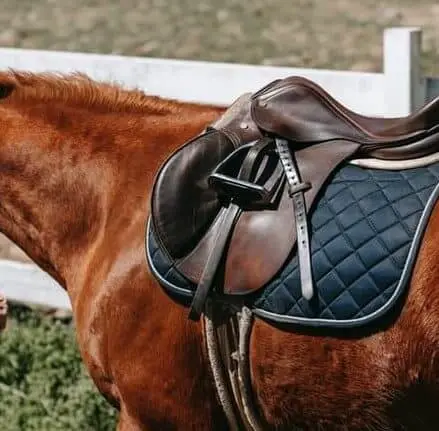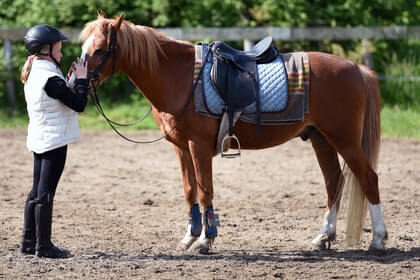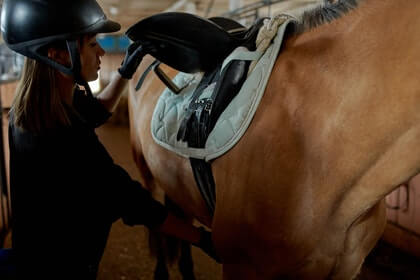Many people take their first ride on trained horses. They never experience the interesting process of breaking a horse. Training a horse to carry a rider is not an easy task. You need patience, time, and understanding to successfully train your horse.
The first step is teaching the animal to accept the saddle on its back. The process can be frustrating for both you and the creature. You should use treats as incentive but also offer plenty of praise throughout training sessions.
The trainer has to understand the horse and be patient in teaching it to carry a rider. It can be a fun experience as a horse learns to understand a rider’s command and aids.
Eventually you’ll be able to put the saddle on without any issue. Once your horse has accepted its equipment, it will be time to tackle how it carries itself under this new weight.
How long does it take to break a horse?
It’s a common misconception that breaking horses is an overnight process. It actually takes around 5 months at the outside to break in a horse, with the time it takes varying depending on how well-trained the horse was before they were broken.
Some people also believe that breaking horses requires cruelty, but this is untrue – every step of the process is about communicating effectively and teaching good behaviors through positive reinforcement.
Back in the day, trainers would use whips and other physical training to keep their horses under control. They’d give them plenty of time before trying new things so it became easier for a horse to get used with what’s happening around him/her while also gaining trust from both riders or owners as well.
A more modern approach now focuses on gentler ways like grooming an bridles made out leather rather than metal ones because they’re kinder-mannered animal friends that do not mind having something placed near its mouth when working closely together.
This way trust can be gained gradually by both parties involved, then slowly progressing on up through advances as needed before reaching full Equine Cooperation Capacity (ECC).

In the modern horse riding world, there are many different ways to communicate with your equine partner. A trainer will use gentle pressure and repetition in order for them get used to each stage of training while still being calm enough so that when cues come from you or another person on a saddle near by (or even far away), they know what’s expected without much confusion.
The type of training a horse received determines its loyalty. It’s more exciting to ride horses trained in respect than fear, which makes them easier and better behaved for those who want an experienced mount or just learning how it feels on a horses’ back.
Is it hard to break a horse in?
Breaking a horse in is not hard. What’s hard, is the process of developing trust between you and your new horse. It can be an emotional journey to get there, but it will all be worth it when they know that you’re their person and they’re willing to follow your lead with just one look from you.
These tips will help:
- Be patient and consistent
- Give them plenty of time for feedings
- Keep things predictable
- Make sure they have enough room to roam
- Don’t force anything on them
- Reward good behavior by giving treats ( Start with something small like oats or apples.You can also try carrots or sugar cubes)
Breaking a horse takes experience and practice. If an inexperienced rider tries to break their own horse, they may end up hurting it more than helping because of mistakes made while training or giving confusing instructions which could put them in danger instead.
For safety purposes, only someone with experience should be allowed to practice with a horse. Errors can very easily cause injury while not giving enough time for learning how to make things work properly.
For an experienced horse rider, breaking your horse to ride will be one of the easier tasks. You’ll need information on how to take care of them including a good diet and exercise plan for their activity levels as well as reading body language cues.
It’s important not only take time out during the day and follow closely behind, as the goal should really be patience.
What is the best age to break in a horse?
What many people don’t know about breaking in horses is that there’s no set time frame for doing so. It depends on what kind of ride you’re looking for and what you would like your horse to do.
The age at which a horse is broken in varies depending on the goals of the breaker. For those who wish to compete with their horses, it is best to wait until they are fully grown and developed before attempting this process. If you want your horse as a riding companion or for general farm work, then waiting until six-months old may be best.
A horse’s final temperament depends on the previous training it has received. If an animal is well-handled and confident, then breaking will take less time than if these qualities are lacking or diminished in some way.

A horse or pony that trusts you will learn faster when introduced to bridle and saddle training. However, it takes an average of 4-6 weeks for the breaking process in order to give them control over their own body without any intervention from humans.
This relies heavily on how quickly horses are able understand commands through positive reinforcement alone (no physical pressure).
The duration will vary according to the personality of the horse. While it will be a challenge to train warm blood to accept a rider, a calm horse will do so with ease.
What are the stages of breaking a horse?
Breaking a horse is a process that takes time and patience.
There are four stages of breaking a horse, which you can read about below.
In the first stage, the animal will be frightened of their handler and unsure of what they want to do next. The second stage is where the trainer starts teaching it simple tasks such as being led around or being fed from your hand. This continues on until they get to Stage 4, where they have mastered all of their training and can be considered fully broken.
Some other key factors on breaking a horse properly are listed below,
Build Trust
Spend time regularly with your horse. Spend hours a day brushing the sleek coat of its neck and shoulders as well as giving it affectionate nicknames like “my little partner in crime.”
You can bond while grooming each other, going on adventures outdoors or playing games inside stables; whatever suits you best. If this works for both parties then training will go much smoother. I mean come one, trust is key when controlling such powerful animals right?
So if you have a new horse, bond with it. The horse needs to have confidence in you, even if it is already trained to carry a rider. Do the same for a younger horse as early as you can and the bonding will make the breaking process easier.
Halter-breaking A Horse
Allow the horse to get used to your touches. You can touch its head, neck, and ears while you stand where the horse can see you. Slowly reach out to the horse when you want to touch it to avoid startling it. When it gets used to the feel of your hands, gradually introduce the halter. Let the horse see and smell the halter.
Then rub the halter on the horse for a few days. Gently place it on the horse’s head. Make multiple attempts to put on the halter before you finally buckle it.
Introduce the Bridle
A bridle with a similar texture to the halter is an ideal option. Place it slightly on your horse’s face and allow them time for familiarity before training with a mouthing bit, which may take some patience as well.
The best way I have found in getting my horses used it properly was by slowly putting a soft training bit into their mouth while they got familiarized.
So start off by using soft mouthing bits like dominoes (or “mouthers“), which can be slowly fed from one end only until they become accustomed enough that you may leave them there without worry.
Saddle-Breaking a Horse
The introduction of a saddle to a young horse should be a gradual process. This way, it can get used and accustomed without as much difficulty when you put something around its back like leathers or stirrups later down the line.
This can be helpful in accomplishing your goal of having an accepting animal that doesn’t panic or buck off from contact as they otherwise would.
When it relaxes under the weight of the saddle pad, gently move the saddle pad to allow the horse to get used to its feel.
When you are first mounting your horse, it is best to test both sides of the saddle. The weight should be evenly distributed between them before applying pressure with one hand and moving around in circles or figure eights if necessary.
You should do this until they get used to their feel from this position only using slow movements that don’t force too much upon either side at once. Then try lowering yourself slowly by pulling on each corner surcingle strap so those areas have some slack while not releasing all hold completely.
Backing Process
The first thing you should do when mounting a horse is get an assistant to stand behind it and hold its head while starting the bridle. Then slowly lower yourself over each of your legs, making sure not too much pressure is put on either side as this can cause discomfort or injury for both human and equine partner.
The best way I’ve found for beginners is to always hold onto something sturdy if there are any around – they’ll give good leverage.

When the horse relaxes, change to a sitting position. Allow it to get comfortable with your weight while you reassure it. Then, the person holding the horse will lead it to take a few steps. Gradually increase the steps until your horse gets used to having a rider on its back while it walks, stops, or turns. Now, your horse is backed. Start training it to understand the basic aids.
How do you ride a horse that hasn’t been ridden in a while?
Riding a horse is an art. It’s not something you can pick up right away and it takes time and patience to master.
It can be intimidating and frightening when you first start out, but it doesn’t have to be.
You need to be patient with your horse. Allow it time and understanding before you move onto the next stage of riding, which will make this process easier for both parties involved! If following these steps on how break horses is done; they soon won’t want anyone else but you by their side – trust me when I say that’s a good thing 😉
A few safety tips: Remember never force or push against an uncooperative animal in order avoid injury (remember even though these creatures are typically much larger than humans). Also ensure there isn’t any fencing between both parties as accidents can happen quickly out here where things aren’t always obvious until someone gets hurt.
It’s important to be safety conscious while teaching a horse new commands.
One of the first things you must do when training your horse is get within its line-of sight and stay calm. When you are handling horses, it is important to keep in mind that they can sense fear. When an animal senses its trainer feels afraid or stressed-out, then this will make the horse feel insecure about what might happen next.
Do not startle your horse with sudden movements. A gentle approach will allow the animal to relax and remain calm, which can result in an exciting ride for both parties involved.

